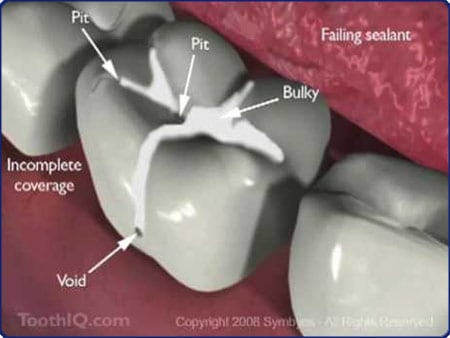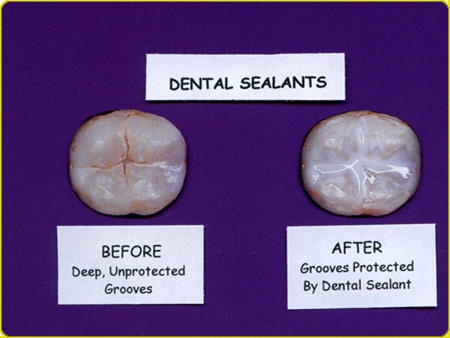Dental Sealants – Protecting Your Teeth
Our teeth are constantly being covered with a sticky film of bacteria called plaque. When we eat or drink anything that contains sugar or starch such as milk, bread, biscuits, lollies, soft drinks, juice, fruit, and many other foods and beverages – bacteria turn the sugar and starch into acids that can attack tooth enamel.
The Reason for Dental Sealants

One of the most common places that tooth decay develops is on the chewing surfaces of the back teeth called premolars and molars. When you run your tongue along the chewing surfaces of the back teeth, you can feel depressions and grooves. These indentations called pits and fissures help to grind food.
Regular brushing and cleaning between teeth with floss or another interdental cleaner help remove food particles and bacteria from the smooth surfaces of tooth enamel. However, pits and fissures are difficult to keep clean. That’s because toothbrush bristles can not reach into the microscopic grooves to remove plaque bacteria and tiny particles of food.
Learn more: How to brush teeth correctly?
The Benefits of Dental Sealants
Because pits and fissures are difficult to keep clean, our participating dentists may recommend dental sealants. A dental sealant is a plastic material that is applied to a chewing surface of a back tooth. The sealant acts as a barrier protecting the enamel from plaque and acid.
Dental sealants have been used safely and effectively for more than two decades. They can benefit children and adults. The likelihood of developing tooth decay on the chewing surfaces begins early in life, so children and teenagers are obvious candidates for sealants. Adults can benefit from sealants too because one never outgrows cavities. Sealants protect vulnerable areas such as pits and fissures by sealing out plaque and food
Applying Sealants

The procedure is simple and fast and it is little if any discomfort. First, the teeth to be sealed are thoroughly cleaned and conditioned. Our participating dentists then apply the sealant to the tooth’s chewing surface where it bonds with enamel. A special curing light may be used to help the sealant harden.

As long as the sealant remains intact, the tooth’s chewing surface will be protected from decay. Sealants that hold up well under the incredible force of everyday chewing usually last for several years before a reapplication is needed. Our participating dentists check their condition during regular examinations.
Dental Sealants and Your Smile

When it comes to your health, prevention is always better than treatment. Properly applied and maintained sealants are extremely helpful in preventing pit-and-fissure decay and they are cost-effective.
To maintain a healthy smile, look for oral hygiene products that have the ADA seal of acceptance which is your assurance that they have met the ADA’s criteria for safety and effectiveness for their intended use.
Brush twice a day with fluoride toothpaste and clean between teeth once a day with floss or another interdental cleaner. Schedule regular dental visits and avoid frequent between-meal snacks.
Ask our participating dentists whether sealants can put extra power behind your prevention program.
Services
Working Time
- Monday - Friday: 08:00 - 19:00
- Saturday: 08:00 - 18:00
- Sunday closed
Contact Info
- Hotline 1: (+84) 908 321 455
- Hotline 2: (+84) 931 857 885
- Mobile: (+84) 8 3925 8778
- Phone: (+84)2 838 258 778
- info@dentalrose.net
- rosedentalclinicvn@gmail.com
 English
English  Tiếng Việt
Tiếng Việt

